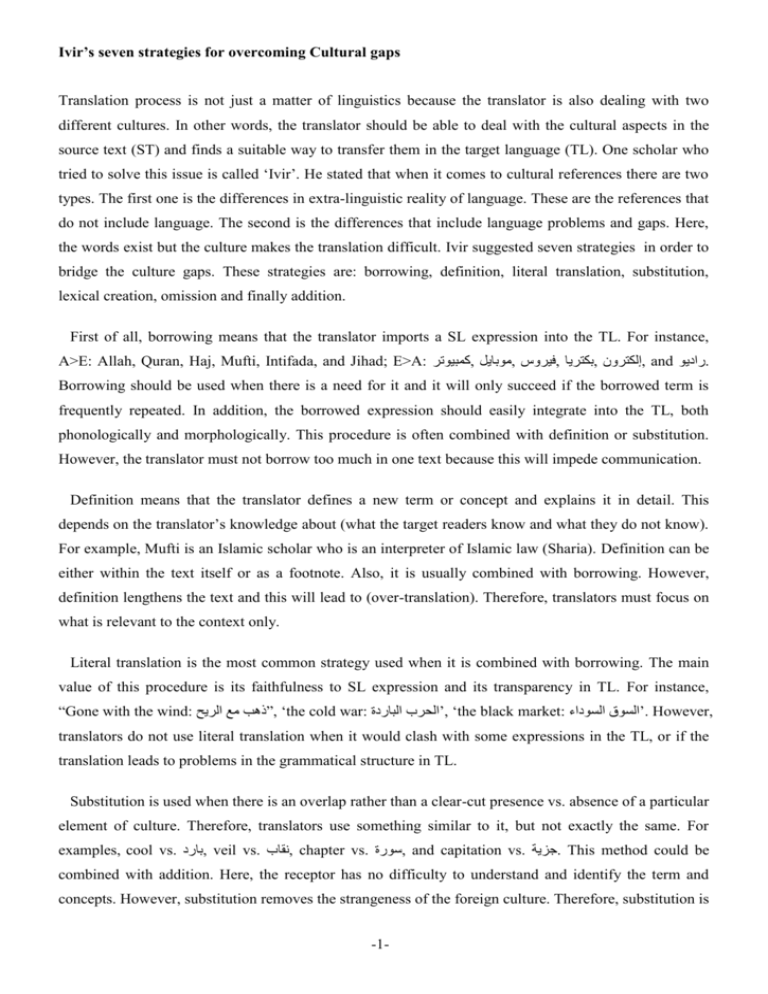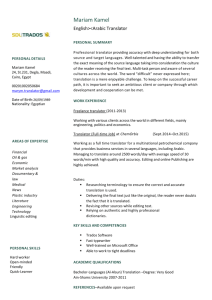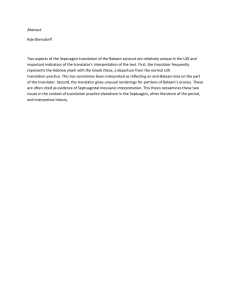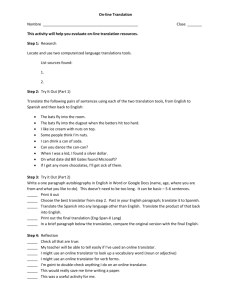Ivir` strategies
advertisement

Ivir’s seven strategies for overcoming Cultural gaps Translation process is not just a matter of linguistics because the translator is also dealing with two different cultures. In other words, the translator should be able to deal with the cultural aspects in the source text (ST) and finds a suitable way to transfer them in the target language (TL). One scholar who tried to solve this issue is called ‘Ivir’. He stated that when it comes to cultural references there are two types. The first one is the differences in extra-linguistic reality of language. These are the references that do not include language. The second is the differences that include language problems and gaps. Here, the words exist but the culture makes the translation difficult. Ivir suggested seven strategies in order to bridge the culture gaps. These strategies are: borrowing, definition, literal translation, substitution, lexical creation, omission and finally addition. First of all, borrowing means that the translator imports a SL expression into the TL. For instance, A>E: Allah, Quran, Haj, Mufti, Intifada, and Jihad; E>A: كمبيوتر, موبايل, فيروس, بكتريا, إلكترون, and راديو. Borrowing should be used when there is a need for it and it will only succeed if the borrowed term is frequently repeated. In addition, the borrowed expression should easily integrate into the TL, both phonologically and morphologically. This procedure is often combined with definition or substitution. However, the translator must not borrow too much in one text because this will impede communication. Definition means that the translator defines a new term or concept and explains it in detail. This depends on the translator’s knowledge about (what the target readers know and what they do not know). For example, Mufti is an Islamic scholar who is an interpreter of Islamic law (Sharia). Definition can be either within the text itself or as a footnote. Also, it is usually combined with borrowing. However, definition lengthens the text and this will lead to (over-translation). Therefore, translators must focus on what is relevant to the context only. Literal translation is the most common strategy used when it is combined with borrowing. The main value of this procedure is its faithfulness to SL expression and its transparency in TL. For instance, “Gone with the wind: ”ذهب مع الريح, ‘the cold war: ’الحرب الباردة, ‘the black market: ’السوق السوداء. However, translators do not use literal translation when it would clash with some expressions in the TL, or if the translation leads to problems in the grammatical structure in TL. Substitution is used when there is an overlap rather than a clear-cut presence vs. absence of a particular element of culture. Therefore, translators use something similar to it, but not exactly the same. For examples, cool vs. بارد, veil vs. نقاب, chapter vs. سورة, and capitation vs. جزية. This method could be combined with addition. Here, the receptor has no difficulty to understand and identify the term and concepts. However, substitution removes the strangeness of the foreign culture. Therefore, substitution is -1- easier if the terms have something in common, for example, tax vs. زكاةor if the terms are functionally similar, for example, chapter and سورة. Other examples can be found in proverbs in both languages. For example, in English we have proverbs " a cat has nine lives, he who steals an egg steals an ox and diamond cut diamond". These have Arabic equivalents with some substitutions. These Arabic proverbs are: ال يفل الحديد إال الحديد و من يسرق بيضة يسرق جمال و القط بسبع أرواح Lexical creation means that the translator produces a new vocabulary, for instance, mobile: جوال, computer: حاسوب, telephone: هاتف, radio: مذياع: and helicopter: مروحية. There is no restriction on how translators invent these new words as long as they are acceptable. However, this procedure is used less than the other procedures because it taxes the brain of both the inventor and the reader. Another term is belly dancing which won entry to the English lexicon about a decade ago. It means الرقص الشرقي Omission is necessitated not by the nature of the cultural element, but by the nature of the communicative situation in which such a cultural element appears. For example, Arab people sometimes greet each other in the morning by saying “”صبحكم هللا بالخير, so when we translate it into English it is enough to say "good morning" because English culture prefers simple greetings. Also, if an Arabic text contains هيئة اإلذاعة البريطانية, then when we translate it into English; we simply omit هيئة اإلذاعة البريطانيةand write BBC, because the English readers will immediately recognise its meaning. Addition of cultural information is used when translating implicit elements of culture. It is combined with lexical creation, borrowing or substitution. For example, if an English text has the abbreviation of MOD, then when we translate it into Arabic; we simply add this explanation ‘’وزارة الدفاع البريطانية, as an Arabic reader may not recognise its meaning. Another example of addition is the English metaphor ‘to Save one's face’ = يحفظ ماء الوجه, here the Arabic word ‘ ’ماءis added because it is used with this Arabic metaphor. To sum up, Ivir provides the translators with helpful procedures in order to bridge the cultural gaps and achieve a communicative translation. However, no one procedure could be used fully for each single text. For an optimum transfer of message, a combination of procedures is better than single use. Therefore, a translator decides on the optimum strategy of translation depending on each individual text s/he is faced with. Now, the problem which faces any translator is how to deal with cultural references when they are only in the text as background. If the translator omits these references, then s/he will lose the faithfulness. At the same time, if the translator translates them, then s/he will give them more importance than what was originally intended. This is a no-win situation; translators can only use compromise and relativity. -2- Reference: “Procedures and strategies for the translation of culture” by Vladimir lvir, cited in "Translation across cultures", Gideon Toury, Bahri Publications, New Delhi, 1987. -3-





